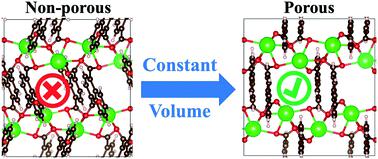当前位置:
X-MOL 学术
›
Mol. Syst. Des. Eng.
›
论文详情
Our official English website, www.x-mol.net, welcomes your
feedback! (Note: you will need to create a separate account there.)
Design principles for the ultimate gas deliverable capacity material: nonporous to porous deformations without volume change
Molecular Systems Design & Engineering ( IF 3.2 ) Pub Date : 2020-10-13 , DOI: 10.1039/d0me00122h Matthew Witman 1, 2, 3 , Sanliang Ling 4, 5, 6, 7, 8 , Vitalie Stavila 1, 2, 3 , Pavithra Wijeratne 1, 2, 3 , Hiroyasu Furukawa 3, 9, 10, 11, 12 , Mark D. Allendorf 1, 2, 3
Molecular Systems Design & Engineering ( IF 3.2 ) Pub Date : 2020-10-13 , DOI: 10.1039/d0me00122h Matthew Witman 1, 2, 3 , Sanliang Ling 4, 5, 6, 7, 8 , Vitalie Stavila 1, 2, 3 , Pavithra Wijeratne 1, 2, 3 , Hiroyasu Furukawa 3, 9, 10, 11, 12 , Mark D. Allendorf 1, 2, 3
Affiliation

|
Understanding the fundamental limits of gas deliverable capacity in porous materials is of critical importance as it informs whether technical targets (e.g., for on-board vehicular storage) are feasible. High-throughput screening studies of rigid materials, for example, have shown they are not able to achieve the original ARPA-E methane storage targets, yet an interesting question remains: what is the upper limit of deliverable capacity in flexible materials? In this work we develop a statistical adsorption model that specifically probes the limit of deliverable capacity in intrinsically flexible materials. The resulting adsorption thermodynamics indicate that a perfectly designed, intrinsically flexible nanoporous material could achieve higher methane deliverable capacity than the best benchmark systems known to date with little to no total volume change. Density functional theory and grand canonical Monte Carlo simulations identify a known metal–organic framework (MOF) that validates key features of the model. Therefore, this work (1) motivates a continued, extensive effort to rationally design a porous material analogous to the adsorption model and (2) calls for continued discovery of additional high deliverable capacity materials that remain hidden from rigid structure screening studies due to nominal non-porosity.
中文翻译:

终极气体可输送容量材料的设计原理:无孔至多孔变形,体积不变
了解多孔材料中气体可输送能力的基本极限至关重要,因为它可以告知技术目标(例如,用于车载车辆)是可行的。例如,对硬质材料的高通量筛选研究表明,它们无法达到最初的ARPA-E甲烷存储目标,但仍然存在一个有趣的问题:柔性材料的可输送容量上限是多少?在这项工作中,我们开发了一个统计吸附模型,该模型专门探讨了本征柔性材料中可传递容量的限制。所产生的吸附热力学表明,与迄今已知的最佳基准系统相比,完美设计的,内在柔性的纳米多孔材料可以实现更高的甲烷可传递容量,而总体积几乎没有变化。密度泛函理论和经典的蒙特卡洛模拟确定了已知的金属有机框架(MOF),该框架验证了模型的关键特征。因此,这项工作(1)激发了持续不断的努力,以合理设计类似于吸附模型的多孔材料,并且(2)呼吁继续发现由于名义上的非均质性而被刚性结构筛选研究隐藏的其他高通量材料。 -疏松。
更新日期:2020-10-13
中文翻译:

终极气体可输送容量材料的设计原理:无孔至多孔变形,体积不变
了解多孔材料中气体可输送能力的基本极限至关重要,因为它可以告知技术目标(例如,用于车载车辆)是可行的。例如,对硬质材料的高通量筛选研究表明,它们无法达到最初的ARPA-E甲烷存储目标,但仍然存在一个有趣的问题:柔性材料的可输送容量上限是多少?在这项工作中,我们开发了一个统计吸附模型,该模型专门探讨了本征柔性材料中可传递容量的限制。所产生的吸附热力学表明,与迄今已知的最佳基准系统相比,完美设计的,内在柔性的纳米多孔材料可以实现更高的甲烷可传递容量,而总体积几乎没有变化。密度泛函理论和经典的蒙特卡洛模拟确定了已知的金属有机框架(MOF),该框架验证了模型的关键特征。因此,这项工作(1)激发了持续不断的努力,以合理设计类似于吸附模型的多孔材料,并且(2)呼吁继续发现由于名义上的非均质性而被刚性结构筛选研究隐藏的其他高通量材料。 -疏松。











































 京公网安备 11010802027423号
京公网安备 11010802027423号